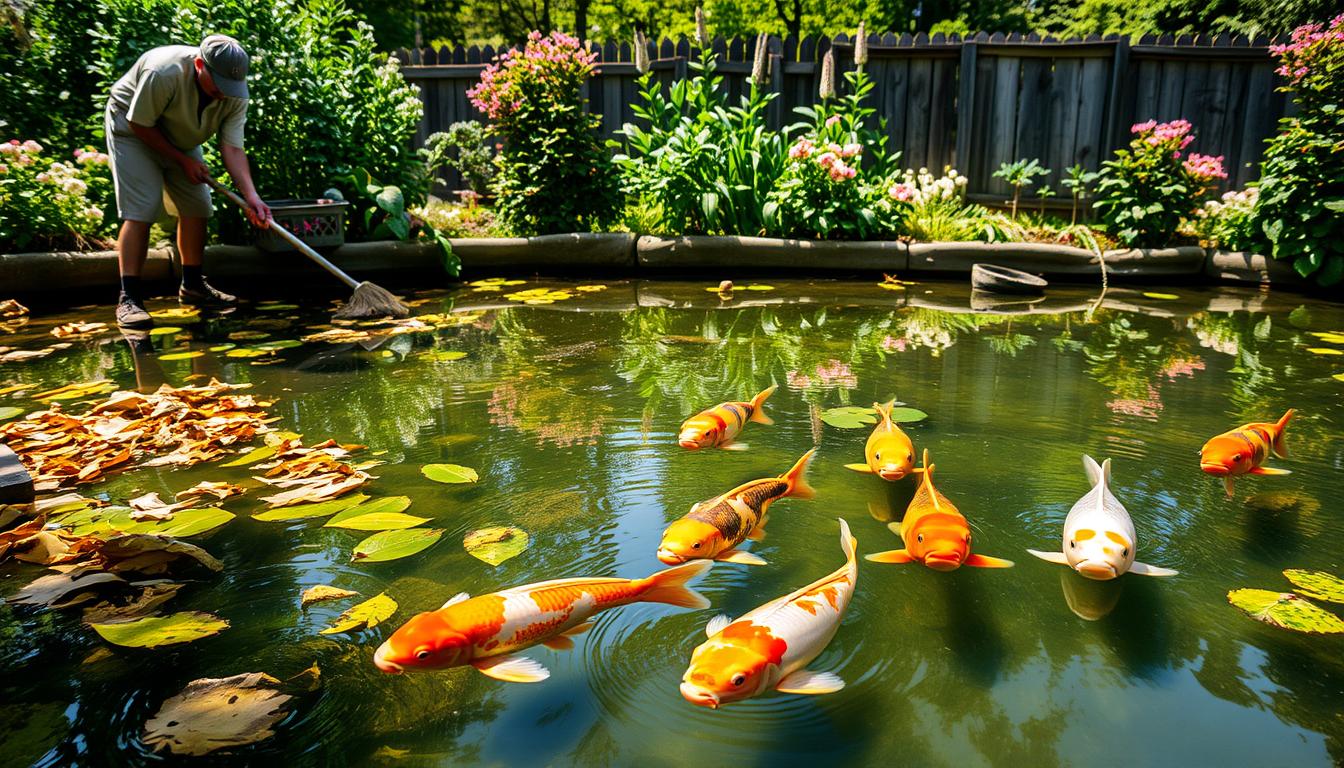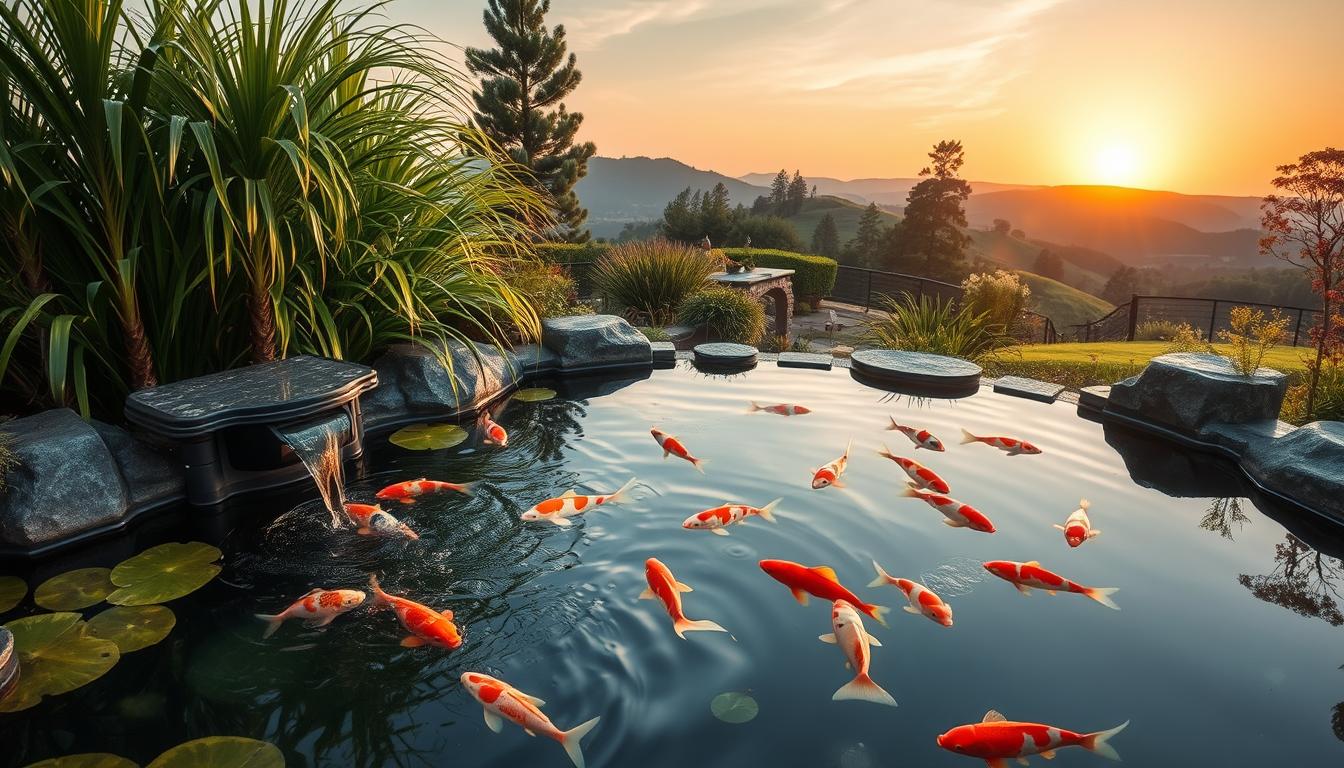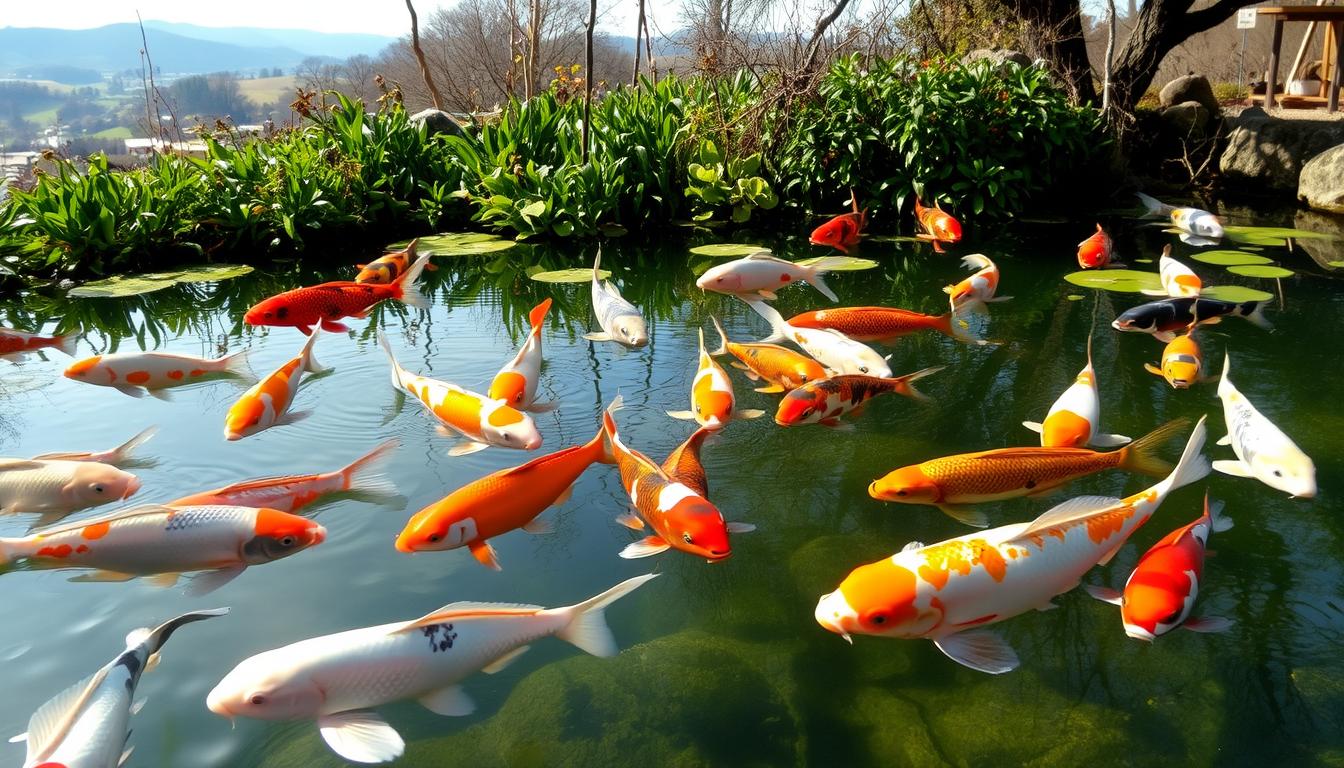When Should You Stop Feeding Koi Fish in Winter and Start Again in Spring?
This post may contain affiliate links.
There’s something magical about watching vibrant, jewel-toned creatures glide beneath the surface of a garden pond. For many, these ornamental carp aren’t just pets—they’re living art, symbols of perseverance and good fortune. But as autumn leaves fall and temperatures drop, a quiet question lingers: “Am I doing enough to protect them?”
Caring for these graceful swimmers isn’t just about aesthetics. Their well-being hinges on understanding nature’s rhythms. When water chills below 50°F, their metabolism slows dramatically. Feeding them during this phase can harm their health, turning uneaten food into toxic waste. Yet restarting meals too late in spring risks malnutrition.
Your pond’s ecosystem acts like a silent partner in this dance. Seasonal shifts alter water quality, oxygen levels, and bacterial activity. By aligning feeding schedules with temperature changes, you create a safe haven that honors both their biological needs and cultural legacy.
Key Takeaways
- Koi feeding depends on water temperature, not calendar dates
- Stop offering food when pond temperatures consistently drop below 50°F
- Resume spring feeding only after temperatures stabilize above 50°F
- Monitor water conditions year-round to prevent health risks
- Proper seasonal care extends lifespan and enhances coloration
Understanding Koi Fish Behavior in Winter
As winter’s chill settles over ponds, Japanese koi undergo remarkable transformations beneath the ice. These cold-blooded creatures rely on their environment to regulate bodily functions, making temperature shifts critical to their survival.
Physiological Changes in Cold Weather
When water temperatures dip below 50°F, their digestive systems slow dramatically. This adaptation prevents energy waste on processing food they can’t metabolize efficiently. You might notice muted coloration patterns during this phase—nature’s way of conserving resources.
Seasonal Dormancy and Metabolism
Different varieties exhibit unique behaviors. While some hover near pond bottoms, others barely move. This dormancy isn’t laziness—it’s a survival strategy. Their oxygen needs drop by 70%, allowing them to thrive in icy conditions.
Three factors influence winter activity levels:
- Genetic traits from selective breeding
- Water depth and insulation quality
- Individual health before cold sets in
Regularly testing water parameters becomes crucial. Ammonia spikes from decaying organic matter can disrupt this delicate balance, even in dormant periods. A well-maintained environment supports their natural rhythms until spring’s warmth returns.
Optimal Time to Stop Feeding Koi Fish
What’s the golden rule for keeping pond inhabitants healthy when seasons change? Time your feedings like a thermostat. When water temperatures dip below 50°F, their digestive systems switch to low gear—imagine trying to run a marathon after eating a holiday feast.
Cold-blooded creatures process food differently in chillier conditions. Enzymes responsible for breaking down nutrients become sluggish below critical thresholds. “Leftover meals turn toxic fast in cold water,” notes aquatic veterinarian Dr. Emily Sato. This biological reality makes timing meals crucial.
Watch for these signs they’re done eating:
- Ignoring floating pellets
- Lingering near pond bottoms
- Reduced surface activity
Testing water temperature daily helps pinpoint the right time to stop. Use a pond thermometer before sunrise when readings are most accurate. If temperatures bounce between 45-55°F, switch to wheat germ-based food that’s easier to digest.
Persisting with regular feedings during cold spells risks ammonia spikes from rotting leftovers. A single overlooked meal can cloud water quality for weeks. Trust their instincts—when they stop nibbling, so should you.
Resuming Feeding in Spring: When and How
As sunlight warms pond surfaces and aquatic plants begin to stir, your pond’s residents awaken from their winter slumber. Water temperatures rising above 50°F trigger metabolic reactivation—a delicate process requiring careful timing. Rushing this transition risks digestive stress, while delays could hinder energy reserves.
Transitioning Diets Gradually
Watch for three clear signals of readiness: increased surface activity, persistent food-seeking behavior, and brighter color intensity. These signs indicate their bodies are primed to process nutrients again. Start with bite-sized portions of wheat germ pellets—easily digestible and rich in fiber.
Introduce variety slowly over 2-3 weeks. Mix high-protein options with leafy greens like spinach or kale. This approach supports their recovering systems while restoring vibrant color patterns. Observe how they respond to different textures and flavors—enthusiastic nibbling means you’re on track.
Follow this phased plan for smooth adaptation:
- Week 1: Feed once daily, portions smaller than a teaspoon
- Week 2: Increase to two light meals with diverse ingredients
- Week 3: Resume regular schedule if water stays above 55°F
Subtle shifts in color saturation often reveal improved health before visible weight gain occurs. Adjust quantities based on how quickly meals disappear—leftovers mean you’ve overshot their capacity. By matching their pace, you’ll ensure a thriving transition into spring’s abundance.
Seasonal Koi Fish Care Tips
Nature’s calendar demands different routines to keep pond ecosystems balanced. Just as trees shed leaves or bloom anew, your aquatic companions require tailored attention through temperature swings. “Consistency matters more than intensity,” says veteran pondkeeper Lisa Tanaka. “Small daily observations prevent big seasonal crises.”

Spring and summer bring active growth phases. Test water weekly for pH balance and ammonia levels—a $15 kit saves $500 in vet bills. Perform 10-15% water changes every fortnight using dechlorinated liquid. Add barley straw bundles to combat algae naturally without harsh chemicals.
Autumn prepares the stage for dormancy. Skim fallen leaves daily to prevent organic sludge buildup. Install a floating de-icer before first frost to maintain oxygen exchange. Check aeration systems monthly—clogged filters suffocate life silently under ice.
Three non-negotiable practices for all seasons:
- Remove uneaten food within 15 minutes
- Inspect pumps during heavy rainfall or snowmelt
- Quarantine new plants for 48 hours before introducing
Notice lethargy or faded colors? Act fast—adjust water parameters before reaching for medications. Proper care enhances longevity, with some specimens reaching 40 years. Their jewel-toned scales will glow brighter when supported by thoughtful, season-smart routines.
Preparing Your Koi Pond for Winter
Winter transforms water gardens into fragile ecosystems needing thoughtful preparation. A well-designed koi pond acts like a natural refrigerator, protecting inhabitants while conserving energy. Start winterization when autumn leaves begin falling—this timing prevents sudden temperature shocks.
Building a Safe Cold-Weather Habitat
Depth determines survival. Ponds under 3 feet risk freezing completely, trapping toxic gases. Experts recommend 4-5 foot depths in northern states—this creates a stable 40°F zone at the bottom. Use a depth gauge to verify measurements before frost arrives.
Aquatic plants serve dual purposes in winter. Their roots filter water naturally, while decaying foliage provides insulation. Trim lilies and lotuses to 6 inches above the rhizome. Leave submerged varieties like hornwort intact—they release oxygen even under ice.
Three protective strategies for harsh conditions:
- Install pond netting to block falling debris
- Place floating de-icers near shallow edges
- Add aeration stones to maintain gas exchange
Check pumps weekly as temperatures drop. Disconnect waterfalls to prevent supercooling. “Insulation isn’t just about warmth,” notes landscape architect Marco Brenner. “It’s about creating consistent conditions for slow metabolism.” Test water parameters monthly—balanced pH levels prevent stress during dormancy.
Essential Koi Fish Pond Setup and Maintenance
What separates a thriving aquatic habitat from a murky puddle? Strategic design. Professional koi farm operations reveal that success lies in balancing three elements: water quality, space allocation, and biological harmony.

Filtration Systems and Water Treatments
Robust filtration acts as your pond’s life support. Multi-stage systems—mechanical, biological, and UV—work like nature’s cleanup crew. They trap debris, break down waste, and zap algae. “A properly sized filter handles twice your pond’s volume,” advises water feature designer Clara Nguyen. This ensures pond water stays toxin-free year-round.
Match your setup to the pond’s size and stock levels. For every inch of pond fish, allow 10 gallons of water. Overcrowding stresses inhabitants and overloads systems. Depth matters too—shallow ponds heat up faster, requiring more frequent water treatment adjustments.
Weekly maintenance keeps everything humming:
- Backwash filters when pressure gauges rise 10%
- Test pH (7.0-8.5 ideal) and ammonia (0 ppm target)
- Clean skimmer baskets after storms
Aeration boosts oxygen levels, especially in warmer months. Subsurface diffusers or waterfall features create circulation that mimics natural streams. Pair these with beneficial bacteria supplements to maintain clarity without harsh chemicals.
Nutritional Needs and Koi Fish Food Selection
The foundation of vibrant pond life lies in what’s served at mealtime. Just like athletes need tailored diets, pond inhabitants require specific nutrients to maintain their jewel-like colors and energy levels year-round.
Choosing the Right Nutrition for Optimal Health
High-quality meals act as natural armor against disease while enhancing growth rates. Look for formulas containing 30-40% protein from sources like shrimp meal or spirulina. These ingredients support muscle development and immune function without clouding water quality.
Seasonal shifts demand menu adjustments. Winter formulas with wheat germ digest easily in cold water, while summer blends pack extra protein for active months. Three key features define premium food:
- Floating pellets that encourage natural feeding behavior
- Probiotics for gut health maintenance
- Color-enhancing carotenoids from natural sources
Water temperature directly impacts how nutrients get processed. Below 60°F, switch to low-protein options to prevent digestive issues. Observe eating patterns closely—if meals linger longer than five minutes, portion sizes likely need reduction.
Compare brands by their ingredient lists rather than flashy packaging. Reputable companies disclose exact protein percentages and source origins. Regular weight checks and scale inspections help gauge if dietary adjustments are needed for specific varieties.
Exploring Popular Koi Varieties and Their Appeal
Centuries of careful selection have painted water gardens with nature’s palette. Over 100 distinct koi varieties now exist, each boasting unique combinations of color, scale patterns, and fin shapes. Japanese breeders began this artistic tradition in the 1820s, transforming common carp into living masterpieces.

Butterfly koi stand out with flowing fins resembling silk ribbons. These elegant swimmers showcase:
- Metallic scales that shimmer in sunlight
- Elongated pectoral fins up to 12 inches long
- Patterns blending traditional and modern aesthetics
Traditional ornamental carp like Kohaku (white body with red markings) remain crowd favorites. Their bold contrasts inspired later varieties, including the tri-colored Taisho Sanke. Breeders achieve these traits through multi-generational pairings, often waiting years for ideal pattern development.
“We’re not just raising fish—we’re preserving moving art.”
Modern techniques allow for dragon-scale textures and neon hues unseen in nature. Yet many enthusiasts value historical breeds for their cultural symbolism. Whether you prefer platinum Ogon or speckled Shusui, each variety brings its own charm to aquatic landscapes.
These living artworks transform ponds into dynamic exhibits. Their swirling colors and graceful movements continue a tradition that began in rice paddies and now graces gardens worldwide.
Understanding Koi Fish Pricing and Budget Considerations
Entering the world of ornamental pond ownership brings both beauty and budgetary considerations. Specimens can range from $5 for basic varieties to over $10,000 for award-winning showstoppers. Three key elements shape expenses: initial setup, ongoing maintenance, and specimen quality.
Initial Setup and Maintenance Expenses
Building a suitable habitat often costs more than the inhabitants themselves. Essential investments include:
- Filtration systems ($500-$5,000)
- Pond liners and aeration ($200-$2,000)
- Water testing kits ($30-$150)
Monthly upkeep adds another layer. Electricity for pumps and heaters can reach $100 during extreme seasons. Treatments for parasites or algae vary greatly—from $20 monthly basics to $300+ emergency solutions.
What Drives Specimen Costs?
Show-quality varieties command premium prices due to:
- Rare pattern combinations (1 in 10,000 odds)
- Proven genetic lineages
- Size milestones (over 24 inches)
While pond-grade options cost $10-$50 per fish, championship bloodlines often exceed $15,000. The number needed depends on pond size—experts recommend one specimen per 250 gallons to prevent overcrowding.
Budget-conscious enthusiasts should:
- Start with younger, smaller specimens
- Prioritize water quality over quantity
- Join breeder waitlists for rare varieties
“A $300 specimen in pristine water outshines a $3,000 star in poor conditions,” notes aquatic consultant Rachel Tan. Smart planning ensures your investment thrives for decades.
How to Choose a Reputable Koi Fish Breeder
Selecting the right source for your aquatic companions shapes their health and beauty for years. Trusted breeders combine artistry with science, cultivating specimens that meet strict genetic standards. Historical records from Japanese exhibitions reveal how champion bloodlines emerge from meticulous care and selective pairings.

Start by researching breeders with proven show success. Those who’ve had specimens exhibited at major events often prioritize quality over quantity. Check online forums and local clubs for testimonials—enthusiasts love sharing experiences about standout sources.
Ask potential suppliers these key questions:
- Can you share hatch dates and parentage records?
- What water parameters do you maintain for juveniles?
- How do you handle disease prevention in your stock?
Compare at least three options before deciding. Seasoned hobbyists often share recommendations through specialty networks or pond-keeping groups. Look for transparency in breeding practices—reputable sources gladly explain their methods.
Verify credentials through koi associations like AKCA or ZNA. Memberships signal adherence to ethical standards and continuous education. Remember: the best investments combine vibrant colors, balanced proportions, and traceable origins.
Maintaining the Health and Longevity of Koi Fish
A well-cared-for pond inhabitant can outlive many household pets when given proper attention. Proper care allows these aquatic jewels to thrive for decades—some surpassing 40 years in ideal conditions. Three pillars support their extended lifespans: pristine water quality, balanced nutrition, and stress-free environments.
Spotting Trouble Before It Escalates
Early detection makes all the difference in keeping aquatic pets healthy. Watch for these warning signs during daily observations:
- Faded colors or frayed fins
- Erratic swimming patterns
- Clamped fins against the body
| Common Issue | Visible Signs | Immediate Action |
|---|---|---|
| Parasites | Flashing against surfaces | Salt bath treatment |
| Bacterial Infection | Red streaks on scales | Water test + antibiotics |
| Nutritional Deficiency | Sunken eyes | Diet adjustment |
Weekly water tests for ammonia and nitrites prevent 80% of health crises. Pair this with monthly visual inspections—check gill movement and body symmetry. “An ounce of prevention keeps specimens vibrant for years,” advises aquatic specialist Mia Johnson.
Enrich their environment with aquatic plants and hiding spots to reduce stress. Rotate food types seasonally, ensuring adequate vitamins and minerals. By combining vigilant monitoring with proactive care, your pond can become a sanctuary where fish live full, active lives.
Conclusion
Successful pond stewardship blends science with respect for centuries-old traditions. By halting meals below 50°F and resuming gradually in spring, you honor their natural rhythms. Regular water quality checks and pond upkeep create conditions where a thriving group of these aquatic jewels can flourish.
Those who keep koi as living art understand their role as caretakers of cultural symbols. Partnering with reputable breeders ensures healthy specimens, while daily observations prevent minor issues from becoming crises. A well-maintained habitat often becomes a source of community pride, echoing beliefs that these creatures bring good fortune.
While goldfish make charming additions to water features, they lack the rich heritage woven into every scale of their larger cousins. Unlike their goldfish relatives, these pond inhabitants carry stories of perseverance passed down through generations.
Ready to deepen your knowledge? Explore trusted resources on seasonal care routines and temperature thresholds. With patience and attention, your efforts can sustain a healthy population that turns every glance at the pond into a moment of wonder.
